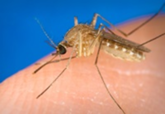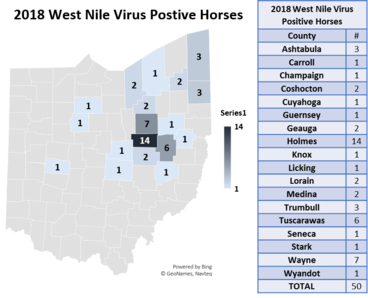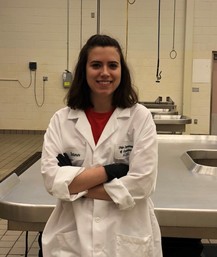 2018 Record Year for West Nile Virus Infections in Horses in Ohio
Dr. Jeff Hayes, DVM, MS, ADDL Pathology Section Head
The 2018 West Nile Virus infection season has come to a close in Ohio, and this year was a record year for confirmed equine cases (50) identified by the ADDL. Horses included had appropriate clinical signs and were confirmed by either serology (presence of IgM antibody in the absence of vaccination history, 48 cases) or by detection of WNV nucleic acid in inflamed horse brain tissue (2 cases).
Infected horses came from 18 of Ohio’s 88 counties, with 54% of confirmed cases coming from 3 counties: Holmes (14), Wayne (7) and Tuscarawas (6). See the map and chart below for location and listing of affected counties with equine WNV cases.
Standardbreds were the breed most affected (21, 42%), followed by 5 Paint and 4 Belgian horses. Two each of Hackney pony, Morgan, Percheron, other Pony, Quarterhorse, and Thoroughbreds were affected, and one each of other breeds (draft horse, Dutch Harness, Friesian, Haflinger, Mini Pony, donkey, mule), and one horse with breed not indicated. Ages affected ranged from 1 to 22 years, and 27 were male (54%), 21 female (42%) and 2 with no gender reported.
The Ohio Department of Health (ODH) reports that there were 64 human WNV cases in Ohio this year, as of 11/26/2018; see the ODH Ohio Mosquito-borne Disease Surveillance here.
Only 14 positive WNV equine cases were confirmed in Ohio in 2017. Mosquito control and proper vaccination of horses are important preventive measures to minimize suffering and death of horses from this viral disease transmitted primarily by the northern house mosquito, Culex pipiens.
|

ADDL develops WGS method for typing Helcococcus ovis
Dr. Yan Zhang, , DVM, PhD, DACVM, ADDL Virology Section Head
Helcococcus ovis is a Gram-positive coccus in the family of Peptostreptococcaceae. The bacterium is catalase-negative and facultatively anaerobic. H. ovis is considered to be an emerging pathogen in veterinary medicine and has been associated with valvular endocarditis in cattle, pulmonary abscess in a horse, and in a sheep with pleuritis and bronchopneumonia. A standard method for differentiation and characterization of this organism has not been established. The ADDL developed a method using whole genome sequence (WGS) for the characterization and typing of H. ovis isolates. A total of 12 WGS genomes from 4 different animal species were used to validate this method. The method is accurate, reproducible, and highly discriminatory for typing and characterization of H. ovis isolates.
Call the ADDL (614-728-6220) if you have any questions about this new method.
Changes in CWD Sample Submission for IHC Testing
Dr. Jeff Hayes, DVM, MS, ADDL Pathology Section Head
The United States Department of Agriculture (USDA) has recently made changes in the procedures required for sample collection from cervids for chronic wasting disease (CWD) testing by immunohistochemistry. Ohio is considered free of CWD and has robust surveillance programs in captive and free-ranging deer. The Ohio ADD has tested over 8000 samples per year, for the last several years. The following changes are now required for veterinarians submitting samples to an approved laboratory for CWD testing, including submission of both fresh and formalin-fixed samples.
Formalin-fixed tissue (10:1 ratio of formalin to tissue sample): 1- OBEX: After removing the brainstem from the foramen magnum, ensure the proper obex sample (bifurcation or “V”) is preserved. Further trim the brainstem section by making a transverse cut ¾ inch in front of the “V” shape bifurcation and an equal distance behind the bifurcation. Place the trimmed obex into the formalin jar. 2- MEDIAL RETROPHARYNGEAL LYMPH NODES (MRPLNs): Remove each left and right MRPLN as done previously, now, longitudinally incise each lymph node. Place half of the left and half of the right node into the formalin jar, and the other halves into a whirl-pak bag (see below).
Fresh tissue (collect samples in one labeled whirl-pak bag): 1- BRAINSTEM: Place the rostral and distal pieces of brainstem in the labeled bag. 2- RETROPHARYNGEAL LYMPH NODES: Place the other halves of each node into the same bag. 3- ID TAGS AND SKIN: Remove the official ID with a 1”X1” piece of ear attached for each animal sampled, place it in the labeled bag and submit with other fresh tissues. DO NOT PLACE IN FORMALIN.
NOTE: If the animal is a trophy animal, submit the official ID and attach a new official ID to another piece of skin. If no official ID is present, the collector must affix one and record the information. Microchips must be in tissue.
Call the ADDL with any questions or concerns at 614-728-6220.
Dr. Jeff Hayes Appointed to Global Working Group with FAO
Dr. Jeff Hayes, ADDL pathologist, was invited to participate in a 3-day global working group workshop at the Food and Agricultural Organization of the United Nations in Rome, Italy, from November 14-16, 2018. The focus of the workshop was to develop educational strategies in key countries to raise awareness of rinderpest in cattle and wildlife in the rinderpest post-eradication era. Although rinderpest has been declared eradicated from the field globally since 2011, stocks of virus and vaccine remain in a number of laboratory facilities throughout the world, and the possibility of a release, inadvertent or intentional, must not be excluded. Plans for educating animal keepers, veterinarians and their staff, veterinary schools and students, and laboratories are being targeted for specific countries to maintain awareness of this devastating disease. Smallpox is the only other disease that has been globally eradicated from the planet.
Meet Our Intern
 Emma Heyman has been an intern in the Pathology section since October 2018. She has a Bachelor’s degree in Zoology from The Ohio State University and will graduate from Columbus State in May 2019 with a degree in veterinary technology At the ADDL, Emma helps with necropsies and is working on a paraffin block project. Emma has volunteered every week for 2 1/2 years at at the American Primate Educational Sanctuary. In her spare time, she trains in Jiu Jitsu martial arts. Emma has 3 cats, a turtle, and is planning to adopt a dog from Columbus State. Welcome aboard Emma!
|
 The Ohio ADDL will be closed on Tuesday, December 25, 2018 in observance of Christmas, and Tuesday, January 2, 2019 in observance of New Year's Day. Have a safe and enjoyable holiday.
For additional information and resources, please visit our website. If you need to contact us regarding an urgent matter, please use our after hours phone number: (888) 456-3405.
ADDL Website
ADDL Test and Fees Search
|